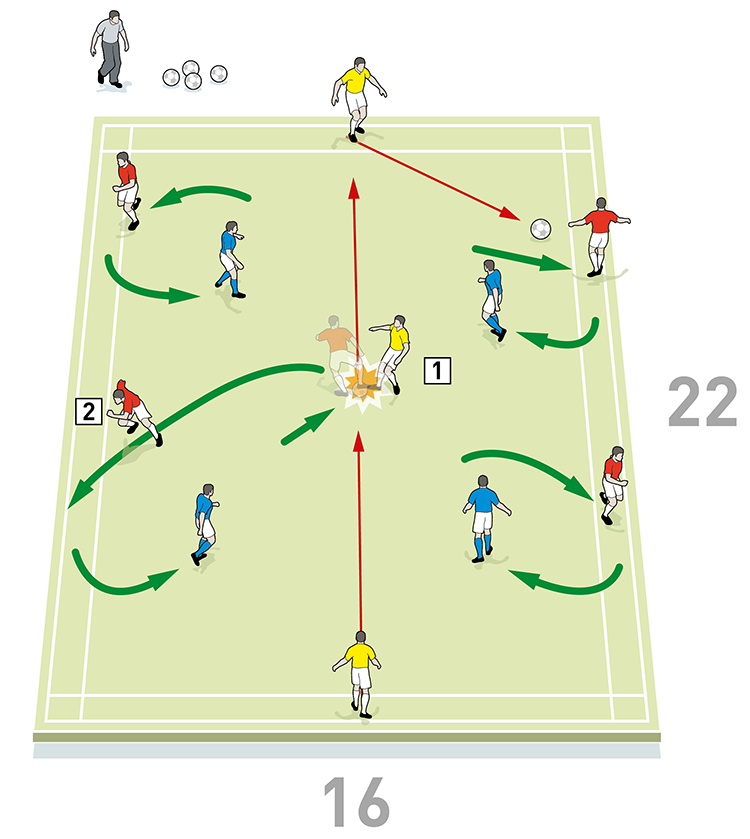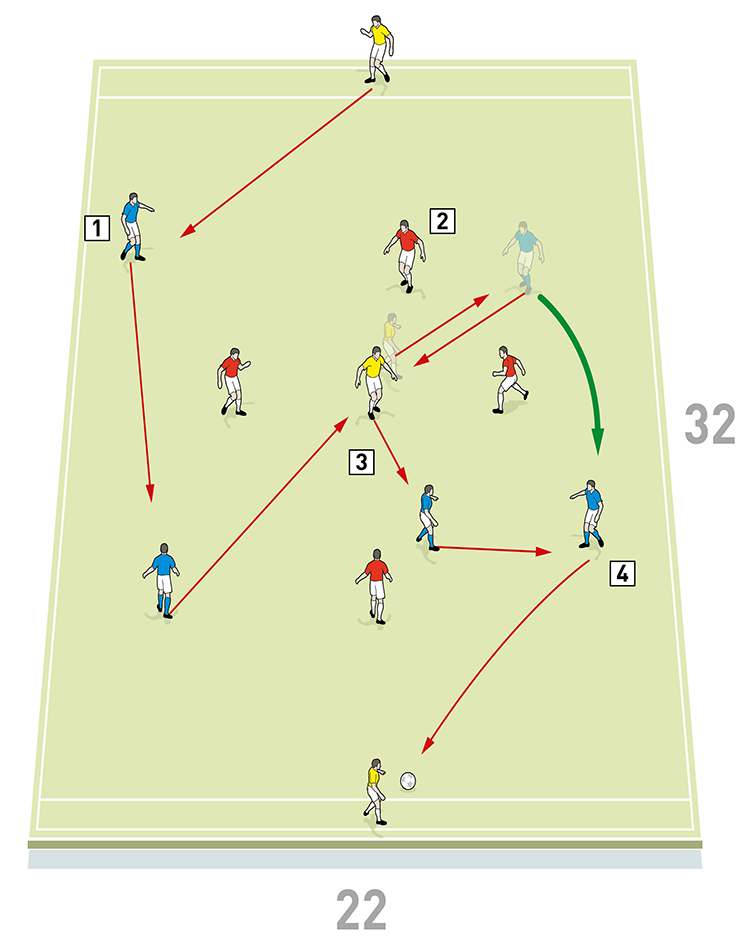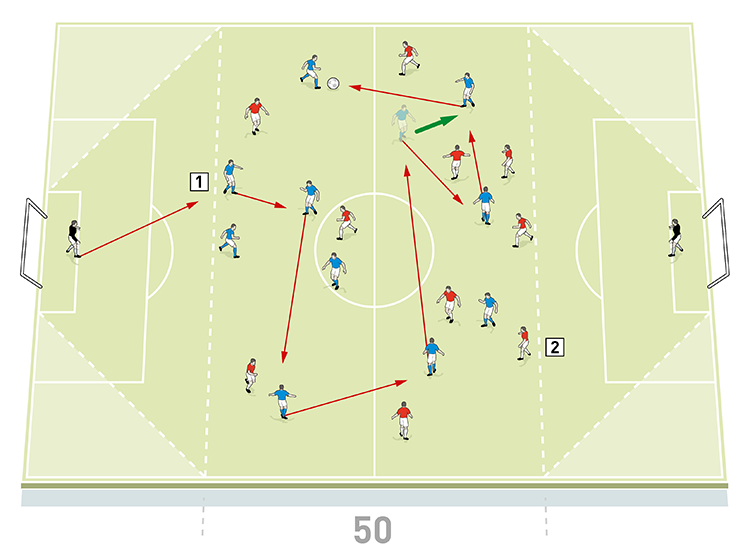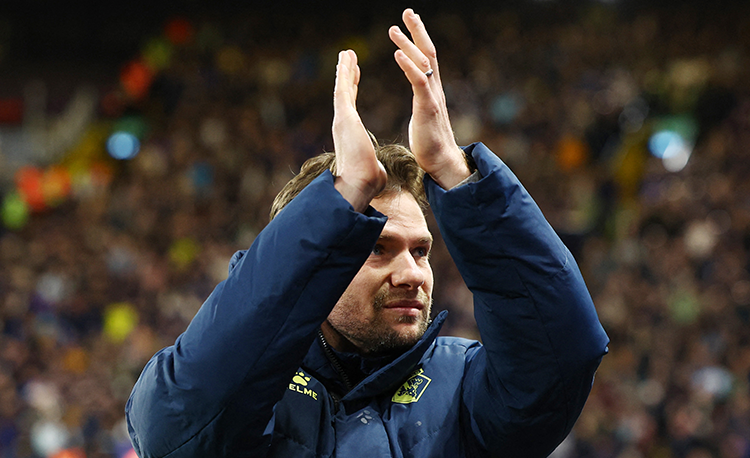You are viewing 1 of your 1 free articles
Breaking lines
This session is all about breaking lines in possession. Due to the way we play, our players need to be able to understand when to switch the play and when to split the opposition, all with the aim of penetrating opponents and allowing us to play forwards.
| Area | Up to full pitch |
| Equipment | Balls, bibs, cones, 2 full size goals |
| No. of Players | Up to 20 players+ 2 goalkeepers |
| Session Time |
Practice 1: 12mins, Progression: 15mins, 11v11 game: 24mins |
This session is all about breaking lines in possession. Due to the way we play, our players need to be able to understand when to switch the play and when to split the opposition, all with the aim of penetrating opponents and allowing us to play forwards.
We always encourage rotation and ask players to run off the back of opponents. Therefore, the session is about when to keep the ball and when to draw the opposition out to then split them. If we cannot penetrate opponents by splitting them, we like our players to be able to switch the play quickly to get out the other side.
This session encourages players to make quick decisions under pressure and to also communicate with each other so that they can see the bigger picture. It is also about the type of in-possession technical play they use, including how to receive the ball, whether it be on the half turn, playing first time around the corner, or quick combinations to play forward.
We believe it is really important that sessions do not deviate too far from the real game. Therefore, this session is football orientated and position specific. This ensures that practice is relevant and repetitive. It also allows us to get the detail into them quickly and efficiently.
This session is split into three parts. The first part is an extension of the warm-up with a technical focus, before then extending the pitch sizes to increase the physical loadings so that players play under more game related stress.
Typically, we would run this session once a week in pre-season to practise our in-possession principles. It is also very good for the players’ conditioning, as we can increase the timings, which in turn increases the loadings. This will also ensure players practise when fatigued which is vital to skill development and decision making.
In season, the timings will be shorter to keep the players’ minds and bodies sharp. During the season, we use this session as a way of replicating our possession principles in a competitive and engaging manner.
What do I get the players to do?
Practice 1
We start the session with a technical practice, focusing on passing and receiving priorities and decision making. We set up an area of 22x16 yards. We’re using 10 outfield players and a goalkeeper, split into two teams of four (the reds and the blues) and three neutral players (the yellows). The blues are on the outside of the area on either side and they work together with the three neutrals, who have one player at each end and one in the centre of the main area.
The reds are the defenders and they cannot press the outside players or the end neutrals, they are only allowed to intercept the ball or tackle the central neutral player. All players are on a maximum of two touches but we encourage them to play with one touch.
Play starts with a pass from the coach to one of the blues, who must keep possession with the help of the neutrals, as shown [1a].
1

2. The ball can be passed around the outside but only three outside passes can be made at most before it has to be played through the central neutral
3. When passing to the central neutral, the pass can either split the defending team or be chipped over the defenders
4. The red defending team can intercept the ball but they are not allowed to press the outside players – they can only tackle the central neutral
The ball can be passed around the outside but only up to three passes can be made before it has to be played through the neutral player in the centre, splitting the defending team with a pass or making a high pass over the top.
If the defenders intercept the ball, they must quickly pass it to a neutral and swap places with the blue team on the outside, as shown [1b]. The practice then resets as quickly as possible to keep it flowing. We play three rounds of four minutes.
1b

2. After gaining possession, the red defenders quickly swap places with the blue outside team. The practice then keeps flowing with the players in their new roles
What are the key things to look out for?
When assigning roles, ideally we make one end neutral player a centre back and the other a keeper, while the middle neutral should either be a centre midfielder or a number 10. This is so the keeper and centre back can see the play in the same way as they would see it in a game. Similarly, the centre midfielder or number 10 can then practise their game awareness, recognizing when to play a bounce pass, when to play around the corner, or when to receive on the back foot and go out the other side.
How do I progress the session?
Progression
We progress the practice by enlarging the area to 32x22 yards. The two teams of four (the reds and the blues) are now both inside the main area, while the three neutral players (the yellows) are positioned as they were before, with one at each end and one in the centre. The blues and the yellow neutrals again work together to keep possession, giving them a 7v4 advantage over the red defenders.
A point is scored if the possession players complete eight consecutive passes or if they manage to transfer the ball from one end player to the other and back by playing through the middle neutral at least once, as shown [2]. If a player passes to an end man, they cannot receive the next pass – this encourages rotation.
2

2. The red team are the defenders and they can press any of the players in the main area
3. A point is scored if a team completes eight consecutive passes, or plays from one end to the other and back, playing through the central neutral at least once
4. The player who passes to an end player cannot receive the next pass back. This encourages players to rotate their positions
The passing players should take as few touches as possible, while the red defending team can press and tackle everyone but the two end neutrals.
We play three rounds of five minutes.
What are the key things to look out for?
With both teams of four in the central area it should encourage quicker decision making, as there is now constant pressure on the ball from the defending team.
The overall aim is to get the passing players to develop an understanding of when, why and how to play through, over or around the opposition. We want to see passing players drawing pressure with a bounce pass, rotating positions and using quick combinations. We also want to see them exhibiting good body shape when receiving the ball, in order to open up the pitch.
How would you put this in a game situation?
11v11 game
We set up for a competitive 11v11 game on a full pitch with a goal and a goalkeeper at each end, and with the corners coned off, as shown [3a].
3a

2. The reds are the defenders and they must press and try to win the ball, but they can’t enter the end breakout zone in their defensive quarter
The game is played in the central half of the pitch, with breakout zones funnelling play towards the goal at either end in the final quarter. Defenders cannot go into these breakout zones.
Normal football rules apply, including offsides and throw ins, but because we are trying to draw a press from the opposition, if the team in possession makes eight consecutive passes, they earn a point.
A conventional goal can also be scored by playing through to a forward, who is allowed to receive the ball in the breakout zone and go 1v1 with the goalkeeper, as shown [3b]. The forward has three touches to score and once he has taken his shot, play restarts with the other team in possession. This encourages teams to play quickly, but it also encourages quick recovery runs from the defending team and teaches them to defend when outnumbered.
3b

2. To score, a pass needs to be played through to an attacker who can run into the end breakout zone to go 1v1 with the keeper. He has three touches to score
3. The defending team cannot enter the breakout zone in front of their goal
To progress the game, players can only play through to the striker under head height and a defender can also track the runner into the breakout zone. This is so that players can practise running off the back of defenders and what type of passing technique to use.
In pre-season training, we use this 11v11 game to practise our shape (1-3-5-2) against various opposition formations and in different game scenarios. During the season, we use it to practise breaking the lines of the opposition we will be playing next.
For this exercise we will play three games of eight minutes.
What are the key things to look out for?
When in possession, if they are being pressed we want to see players recognising where the overload is. We want to see them switching the ball to get out the other way. Once the ball has been switched, we want to see if we can penetrate with runners beyond – and if not, we want to see them recycle the ball, switch again, or split the defence, depending on the positions of the opposition.
Technically, we want to see players using the correct type and weight of pass and understanding when to receive on the half turn and when to combine with team mates quickly.
What are the typical mistakes players might make and how do I avoid them?
The main mistake is that players tend to take too many touches. To solve this, try adding conditions to the activities and limiting the number of touches allowed when on the ball.
Related Files
Editor's Picks
Deep runs in the final third
Using the goalkeeper in build-up play
Pressing principles
Intensive boxes drill with goals
Penetrating the final third
Creating and finishing
My philosophy
Pressing initiation
Compact team movement
Coaches' Testimonials

Alan Pardew

Arsène Wenger

Brendan Rodgers

Carlos Carvalhal

José Mourinho

Jürgen Klopp

Pep Guardiola

Roy Hodgson

Sir Alex Ferguson

Steven Gerrard
Coaches' Testimonials

Gerald Kearney, Downtown Las Vegas Soccer Club

Paul Butler, Florida, USA

Rick Shields, Springboro, USA

Tony Green, Pierrefonds Titans, Quebec, Canada
Join the world's leading coaches and managers and discover for yourself one of the best kept secrets in coaching. No other training tool on the planet is written or read by the calibre of names you’ll find in Elite Soccer.
In a recent survey 92% of subscribers said Elite Soccer makes them more confident, 89% said it makes them a more effective coach and 91% said it makes them more inspired.
Get Monthly Inspiration
All the latest techniques and approaches
Since 2010 Elite Soccer has given subscribers exclusive insight into the training ground practices of the world’s best coaches. Published in partnership with the League Managers Association we have unparalleled access to the leading lights in the English leagues, as well as a host of international managers.
Elite Soccer exclusively features sessions written by the coaches themselves. There are no observed sessions and no sessions “in the style of”, just first-hand advice delivered direct to you from the coach.









